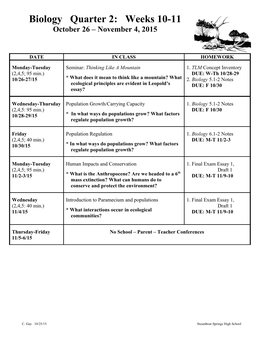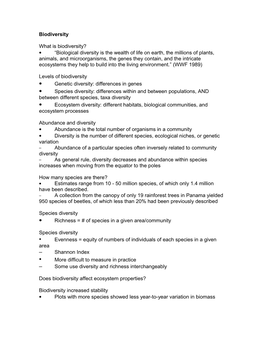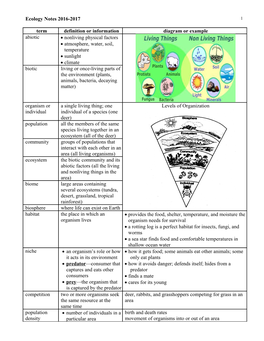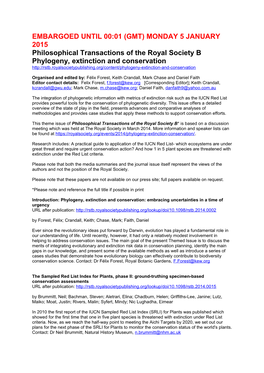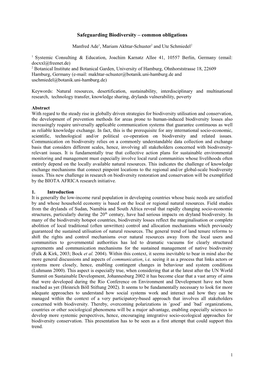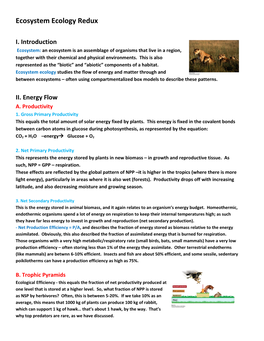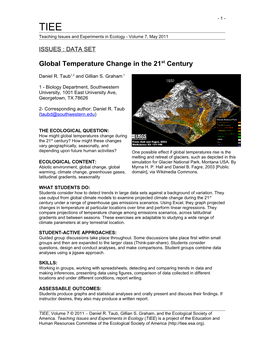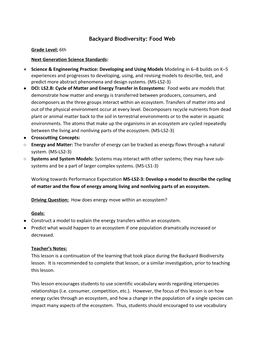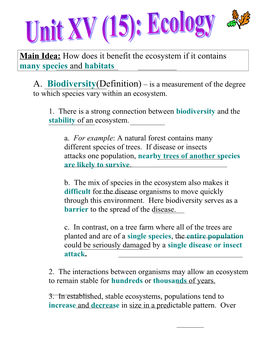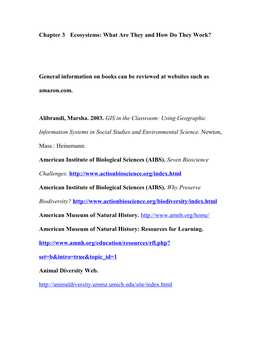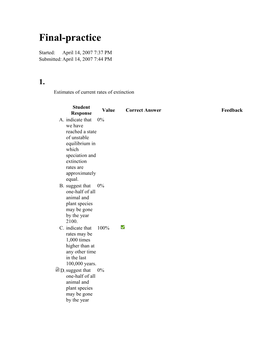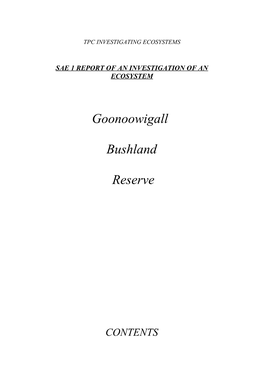Ecology and Environment
Option G.2 Ecology of Communities
Option G.2 Ecology of Communities. G.2.2 Explain the following iunteractions between species, giving two examples of each: competition, herbivory, predation, parasitism, and mutualism.
Topical Understanding
Biology Quarter 2: Weeks 10-11. Topical Understanding. Populations, collections of individuals of the same species that regularly interbreed, are the functional unit of both ecology and evolution. Most populations, under ideal conditions, tend to grow.
What Is Biodiversity?
What is biodiversity? Biological diversity is the wealth of life on earth, the millions of plants, animals, and microorganisms, the genes they contain, and the intricate ecosystems they help to build into the living environment. (WWF 1989). Levels of biodiversity.
Ecology Notes 2016-2017
Ecology Notes 2016-2017. nonliving physical factors. atmosphere, water, soil, temperature. provides the food, shelter, temperature, and moisture the organism needs for survival. a rotting log is a perfect habitat for insects, fungi, and worms.
Philosophical Transactions of the Royal Society B
EMBARGOED UNTIL 00:01 (GMT) MONDAY 5 JANUARY 2015. Philosophical Transactions of the Royal Society B. Phylogeny, extinction and conservation. Organised and edited by: Félix Forest, Keith Crandall, Mark Chase and Daniel Faith.
Biodiversity Research Ethical and Common Obligations
Safeguarding Biodiversity common obligations. Manfred Ade1, Mariam Akhtar-Schuster2 and Ute Schmiedel2. 1 Systemic Consulting & Education, Joachim Karnatz Allee 41, 10557 Berlin, Germany (email: ).
Ecosystem Ecology Redux
Ecosystem Ecology Redux. Ecosystem: an ecosystem is an assemblage of organisms that live in a region, together with their chemical and physical environments. This is also represented as the biotic and abiotic components of a habitat.
Teaching Issues and Experiments in Ecology - Volume 7, May 2011
Teaching Issues and Experiments in Ecology - Volume 7, May 2011. ISSUES : DATA SET Global Temperature Change in the 21st Century. Daniel R. Taub1,2 and Gillian S. Graham1. 1 - Biology Department, Southwestern University, 1001 East University Ave, Georgetown, TX 78626.
The Shift of an Atmospheric Pollutant to an Underground Aid
Disclaimer This paper partially fulfills a writing requirement for first year (freshman) engineering students at the University of Pittsburgh Swanson School of Engineering. Thispaperis a student, not a professional , paper. This paper is based on publicly.
Ireland S Planning Document 1 Contained Several Actions on Financing
Ireland s planning document 1 contained several actions on financing. Consider the development of financial instruments/incentives to promote the conservation of biodiversity. Biodiversity will be made a specific objective of ODA, and all support to.
Backyard Biodiversity: Food Web
Backyard Biodiversity: Food Web. Grade Level:6th. Next Generation Science Standards. Science & Engineering Practice: Developing and Using Models Modeling in 6 8 builds on K 5 experiences and progresses to developing, using, and revising models to describe.
1. There Is a Strong Connection Between Biodiversity and the Stability of an Ecosystem
Main Idea: How does it benefit the ecosystem if it contains many species and habitats. A. Biodiversity(Definition) is a measurement of the degree to which species vary within an ecosystem. 1. There is a strong connection between biodiversity and the stability of an ecosystem.
Readings for Miller L1te-15 by Chapter
Chapter 3Ecosystems: What Are They and How Do They Work? General information on books can be reviewed at websites such as amazon.com. Alibrandi, Marsha. 2003. GIS in the Classroom: Using Geographic Information Systems in Social Studies and Environmental Science. Newton, Mass.: Heinemann.
1) Define Niche in Relation to Evolving Characteristics
1) Define niche in relation to evolving characteristics. a.List multiple biotic and abiotic factors that determine a niche. b.Interpret graphs that represent components of an organism s niche. c.Compare and contrast the niches of different organisms.
Final-Practice
Final-practice.
Tpc Investigating Ecosystems
TPC INVESTIGATING ECOSYSTEMS. SAE 1 REPORT OF AN INVESTIGATION OF AN ECOSYSTEM. 1.0 INTRODUCTION - page 3. 1.1 Characteistics of the dry schlerophyll forest. 2.0 TECHNIQUES AND EQUIPMENT USED - page 3. 2.1 Transect and Quadrat. 4.0 ECOLOGY OF THE SITE - page 4. 5.0 GOVERNMENT CONTROLS - page 5.
- MATH 3080: Statistical Report Assignment No.8
- Minutes of the Village Hallcommittee Meeting
- This Should Be the Title of Your Paper
- Representatives from the Eleven Participating Fisheries Administrations, Regionalfishery
- Determination Under the Defence Enterprise Agreement 2017-2020No. 1 of 2017, Allowancesand
- Department:Economic and Social Engagement, Green Growth Platform
- Special Right Triangles
- Greater Toronto Services Board Act, 1998, S.O. 1998, C. 23
- Burnley, Pendle and Rossendale Council for Voluntary Service
- GHS Theatre Boosters Scholarship 2018
- Buckno Lisicky & Company Has Moved to Two City Center
- Jeff Kremer Burlington, Ky. Graduated from Highlandshigh School in 1983. He Was a Two Time
- System Contract Administrator - 2 T P - JO9847
- Resident S Parking Permit
- Gossip: a One Act Play
- Optimal Forest Management in Sweden with Consideration
- CS502-Fundamentals of Algorithmslecture No.30
- Number Amendment to Type Services Agreement
- Senior Clinical Fellow in Emergency Medicine (4 Posts)
- The Community Investment Grant Fund
- Don T Text and Drive
- Corporations: Introduction and Operating Rules 2-1
- Pension 1:1 Preparation Sheet
- Determine Ph with Ph Indicator Strips and Universal Indicator Solutions
- DOSI New Technologies WG Marine Imaging Workshop Report December 2015
- The University S Academic Ethical Framework

